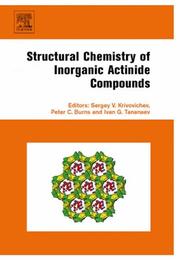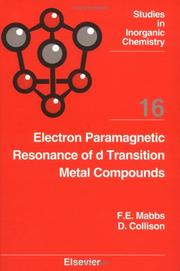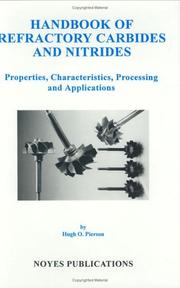| Listing 1 - 10 of 23 | << page >> |
Sort by
|
Book
ISBN: 008100060X 0081000413 9780081000601 9780081000410 Year: 2016 Publisher: Amsterdam, [Netherlands] : Woodhead Publishing,
Abstract | Keywords | Export | Availability | Bookmark
 Loading...
Loading...Choose an application
- Reference Manager
- EndNote
- RefWorks (Direct export to RefWorks)
Book
ISBN: 0128093684 012809379X 9780128093689 9780128093795 Year: 2016 Publisher: Amsterdam, Netherlands : Elsevier,
Abstract | Keywords | Export | Availability | Bookmark
 Loading...
Loading...Choose an application
- Reference Manager
- EndNote
- RefWorks (Direct export to RefWorks)
Transition metal complexes. --- Metal complexes --- Transition metal compounds

ISBN: 9780444521118 0444521119 9780080467917 0080467911 1280747153 9786610747153 Year: 2007 Publisher: Amsterdam ; Oxford : Elsevier,
Abstract | Keywords | Export | Availability | Bookmark
 Loading...
Loading...Choose an application
- Reference Manager
- EndNote
- RefWorks (Direct export to RefWorks)
Structural Chemistry of Inorganic Actinide Compounds is a collection of 13 reviews on structural and coordination chemistry of actinide compounds. Within the last decade, these compounds have attracted considerable attention because of their importance for radioactive waste management, catalysis, ion-exchange and absorption applications, etc. Synthetic and natural actinide compounds are also of great environmental concern as they form as a result of alteration of spent nuclear fuel and radioactive waste under Earth surface conditions, during burn-up of nuclear fuel in reactors, represen
Book
Abstract | Keywords | Export | Availability | Bookmark
 Loading...
Loading...Choose an application
- Reference Manager
- EndNote
- RefWorks (Direct export to RefWorks)

ISBN: 9780444521118 0444521119 9780080467917 0080467911 9786610747153 1280747153 Year: 2007 Publisher: Amsterdam ; Oxford : Elsevier,
Abstract | Keywords | Export | Availability | Bookmark
 Loading...
Loading...Choose an application
- Reference Manager
- EndNote
- RefWorks (Direct export to RefWorks)
Structural Chemistry of Inorganic Actinide Compounds is a collection of 13 reviews on structural and coordination chemistry of actinide compounds. Within the last decade, these compounds have attracted considerable attention because of their importance for radioactive waste management, catalysis, ion-exchange and absorption applications, etc. Synthetic and natural actinide compounds are also of great environmental concern as they form as a result of alteration of spent nuclear fuel and radioactive waste under Earth surface conditions, during burn-up of nuclear fuel in reactors, represen
Actinium compounds. --- Transition metal compounds. --- Chemicals --- Actinide compounds --- Transition metal compounds

ISBN: 9780444873941 0444873945 9780080887425 0080887422 1281790613 9786611790615 Year: 1989 Publisher: Amsterdam, The Netherlands, ; New York : New York, NY, U.S.A. : Elsevier ; Distributors for the U.S. and Canada, Elsevier Science Pub. Co.,
Abstract | Keywords | Export | Availability | Bookmark
 Loading...
Loading...Choose an application
- Reference Manager
- EndNote
- RefWorks (Direct export to RefWorks)
In this book the author presents an up-to-date summary of existing information on the structure, electronic properties, chemistry and catalytic properties of transition metal oxides. The subjects covered in the book can be divided into three sections. The first (chapters 1 to 3) covers the structural, physical, magnetic, and electronic properties of transition metal oxides. Although the emphasis is on surface properties, relevant bulk properties are also discussed. The second section (chapters 4 to 7) covers surface chemical properties. It includes topics that describe the importance of surf
Surface chemistry --- Catalysis --- Transition metal oxides --- Catalysis. --- Surface chemistry. --- Transition metal oxides.

ISBN: 9781483291499 1483291499 0444898522 9780444898524 1322268851 Year: 1992 Publisher: Amsterdam, Netherlands : Elsevier,
Abstract | Keywords | Export | Availability | Bookmark
 Loading...
Loading...Choose an application
- Reference Manager
- EndNote
- RefWorks (Direct export to RefWorks)
Electron paramagnetic resonance (epr) spectroscopy is a sensitive and versatile method of studying paramagnets, which is finding increasing use in chemistry, biochemistry, earth and materials sciences. The technique is treated both qualitatively and quantitatively, with a progressive increase in sophistication in each succeeding chapter. Following a general introductory chapter, the first half of the book deals with single unpaired electron systems and considers both metal and ligand Zeeman, hyperfine and quadrupole interactions. The simulation of these spectra is discussed, followed by the r
Book
ISBN: 9780128096543 0128096543 9780128095911 0128095911 Year: 2016 Publisher: Amsterdam, [Netherlands] : Elsevier,
Abstract | Keywords | Export | Availability | Bookmark
 Loading...
Loading...Choose an application
- Reference Manager
- EndNote
- RefWorks (Direct export to RefWorks)
Spectral Methods in Transition Metal Complexes provides a conceptual understanding on how to interpret the optical UV-vis, vibrational EPR, and NMR spectroscopy of transition metal complexes. Metal complexes have broad applications across chemistry in the areas of drug discovery, such as anticancer drugs, sensors, special materials for specific requirements, and catalysis, so a thorough knowledge in preparation and characterization of metal complexes, while niche, is critical. Accessible to both the seasoned researcher and the graduate student alike, this book provides readers with a single source of content that addresses spectral methods in transition metal complexes.
Transition metal complexes --- Spectra. --- Métaux de transition --- Complexes --- Spectres. --- Metal complexes --- Transition metal compounds --- Métaux de transition

ISBN: 0444873945 9786611790615 1281790613 0080887422 9780444873941 9780080887425 Year: 1989 Volume: 45 Publisher: Amsterdam, The Netherlands, ; New York : New York, NY, U.S.A. : Elsevier ; Distributors for the U.S. and Canada, Elsevier Science Pub. Co.,
Abstract | Keywords | Export | Availability | Bookmark
 Loading...
Loading...Choose an application
- Reference Manager
- EndNote
- RefWorks (Direct export to RefWorks)
In this book the author presents an up-to-date summary of existing information on the structure, electronic properties, chemistry and catalytic properties of transition metal oxides. The subjects covered in the book can be divided into three sections. The first (chapters 1 to 3) covers the structural, physical, magnetic, and electronic properties of transition metal oxides. Although the emphasis is on surface properties, relevant bulk properties are also discussed. The second section (chapters 4 to 7) covers surface chemical properties. It includes topics that describe the importance of surf
Catalysis --- Surface chemistry --- Chemistry, Surface --- Interfaces, Chemistry of --- Surface phenomena --- Surfaces (Chemistry) --- Chemistry, Physical and theoretical --- Capillarity --- Surface energy --- Surface tension --- Surfaces (Physics) --- Activation (Chemistry) --- Transition metal oxides. --- Transition metal oxides --- Catalysis. --- Surface chemistry. --- Metallic oxides --- Transition metal compounds

ISBN: 1282002805 081551770X 9786612002809 1282769340 0080946291 9786612769344 1591240921 0815513925 9781591240921 9780815517702 9780815513926 Year: 1996 Publisher: Westwood, N.J. : Noyes Publications,
Abstract | Keywords | Export | Availability | Bookmark
 Loading...
Loading...Choose an application
- Reference Manager
- EndNote
- RefWorks (Direct export to RefWorks)
Refractory carbides and nitrides are useful materials with numerous industrial applications and a promising future, in addition to being materials of great interest to the scientific community. Although most of their applications are recent, the refractory carbides and nitrides have been known for over one hundred years. The industrial importance of the refractory carbides and nitrides is growing rapidly, not only in the traditional and well-established applications based on the strength and refractory nature of these materials such as cutting tools and abrasives, but also in new and promising
Refractory transition metal compounds --- Carbides. --- Nitrides. --- Metallography. --- Heat resistant alloys --- Surface hardening --- Carbon compounds --- Ceramic metals --- Refractory materials --- Transition metal compounds
| Listing 1 - 10 of 23 | << page >> |
Sort by
|

 Search
Search Feedback
Feedback About UniCat
About UniCat  Help
Help News
News